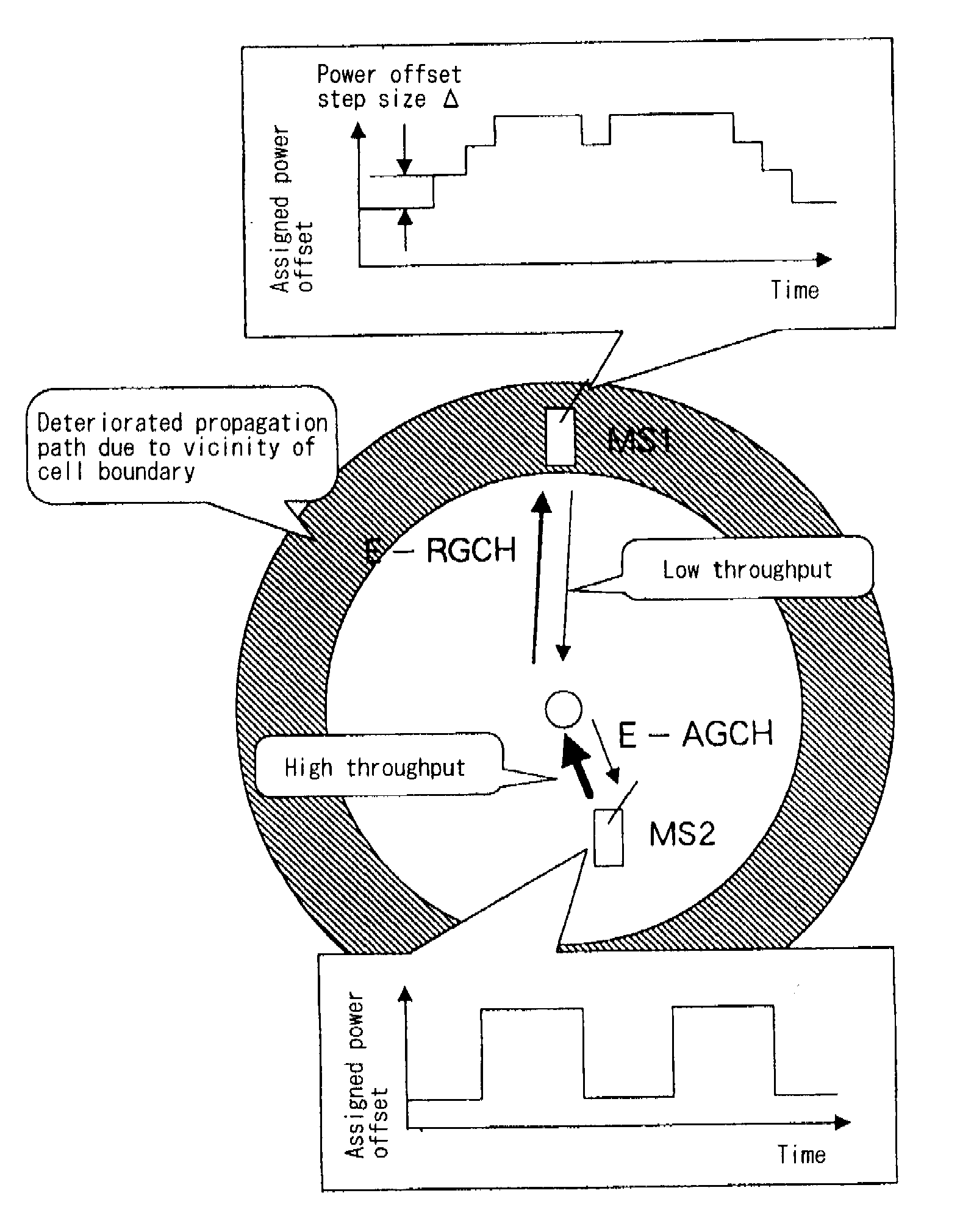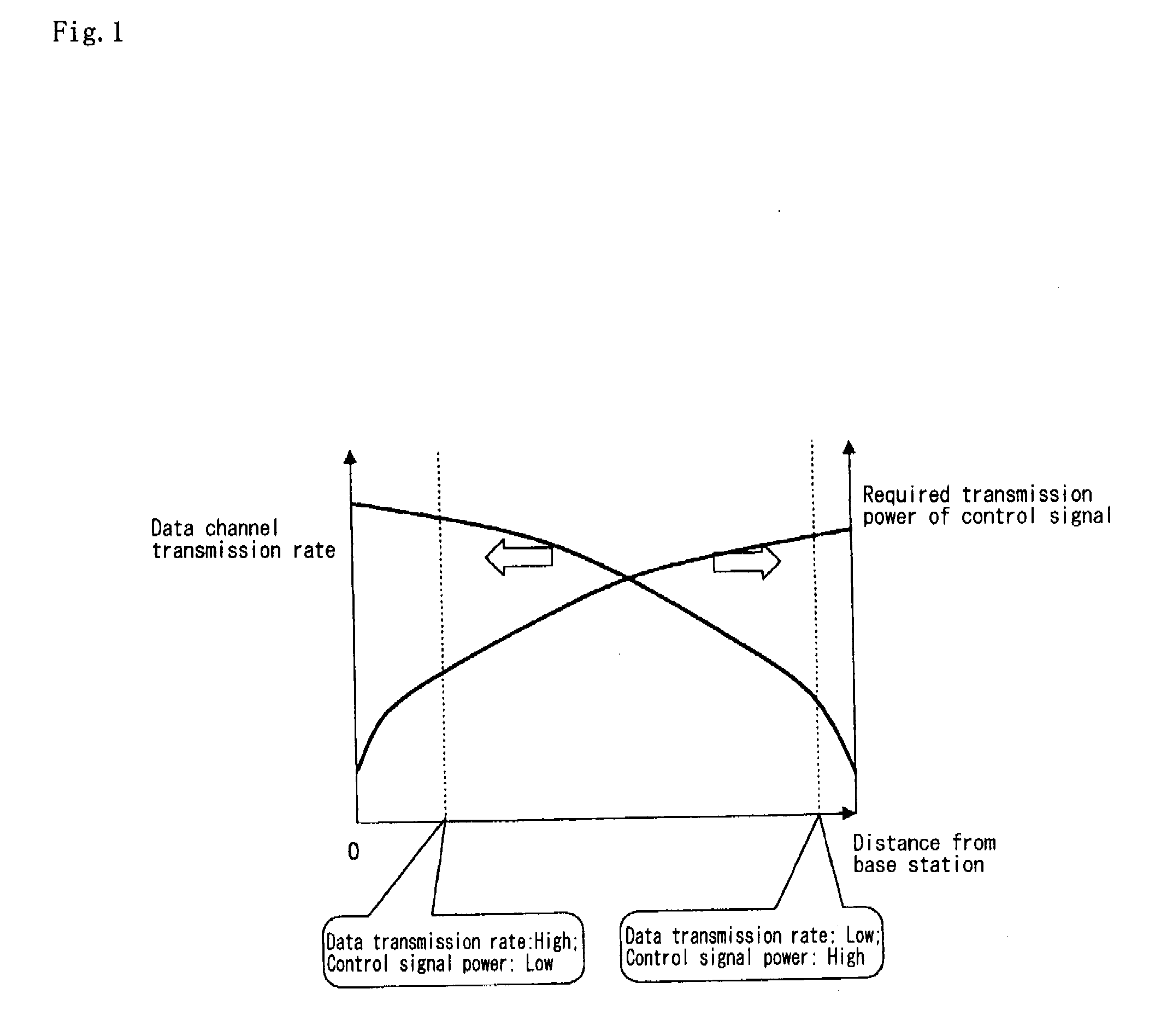Radio communication method, radio communication system, base station, and mobile station
a radio communication system and radio communication technology, applied in the field of radio communication methods, can solve the problems of increasing the ratio of desired signal power to interference signal power (sir), occurrence of bit determination errors, and increasing the loss of radio signal propagation, so as to reduce the power of control signal on a downlink, increase the amount of power that can be used for other downlinks, and increase the throughput of downlinks
- Summary
- Abstract
- Description
- Claims
- Application Information
AI Technical Summary
Benefits of technology
Problems solved by technology
Method used
Image
Examples
first exemplary embodiment
[0046]FIG. 2 shows the radio communication system that is the first exemplary embodiment of the present invention. The example here described is EUDCH (Enhanced Uplink Dedicated Channel), which is a method of high-speed packet transmission on a 3GPP uplink.
[0047]Referring to FIG. 2, the radio communication system is a system that employs the (UL (uplink) data transmission / DL (downlink) control channel / pilot determination / base station determination / bit number alteration) construction of the first embodiment and is made from: base station 101, a plurality of mobile stations 111 and 112, and base station controller 121 to which base station 101 is connected. Base station 101 transmits a pilot channel (CPICH: Common Pilot Indicator Channel), which is a known signal, to all mobile stations in the cell at a fixed power.
[0048]Base station 101 and mobile station 111 set individual control channels (DPCCH: Dedicated Physical Control Channels) on uplinks and downlinks, and set an HS-PDSCH (Hi...
second exemplary embodiment
[0078]The radio communication system that is the second exemplary embodiment of the present invention employs the construction (UL data transmission / DL control channel / separate channel power determination / base station determination / bit number alteration) of the first embodiment. The radio communication system of the first exemplary embodiment is of a configuration in which a mobile stations measures common pilot signal reception quality and reports to the base station in order to estimate the downlink propagation paths. In contrast, the radio communication system of the present embodiment differs from the first exemplary embodiment in that, instead of this estimation of downlink propagation paths, the propagation paths of a mobile stations are estimated from the DPCCH transmission power for which closed-loop transmission power control is implemented to attain a prescribed reception quality.
[0079]The construction of the radio communication system of the present embodiment is next des...
third exemplary embodiment
[0082]The radio communication system that is the third exemplary embodiment of the present invention employs the construction (UL data transmission / DL control channel / pilot determination / base station determination / shared number alteration) of the third embodiment. The radio communication system of the first exemplary embodiment is of a configuration that uses E-RGCH in which the number of information bits is less than in E-AGCH to reduce the control signal transmission power of downlinks for a mobile station having poor propagation paths. In contrast, the radio communication system of the present embodiment differs from the first exemplary embodiment in that, instead of using E-RGCH to reduce the control signal transmission power of downlinks for a mobile station in which the propagation path is poor, common scheduling information is transmitted by E-AGCH to a plurality of mobile stations for which propagation path conditions are poor.
[0083]The following explanation regards the conf...
PUM
 Login to View More
Login to View More Abstract
Description
Claims
Application Information
 Login to View More
Login to View More - R&D
- Intellectual Property
- Life Sciences
- Materials
- Tech Scout
- Unparalleled Data Quality
- Higher Quality Content
- 60% Fewer Hallucinations
Browse by: Latest US Patents, China's latest patents, Technical Efficacy Thesaurus, Application Domain, Technology Topic, Popular Technical Reports.
© 2025 PatSnap. All rights reserved.Legal|Privacy policy|Modern Slavery Act Transparency Statement|Sitemap|About US| Contact US: help@patsnap.com



